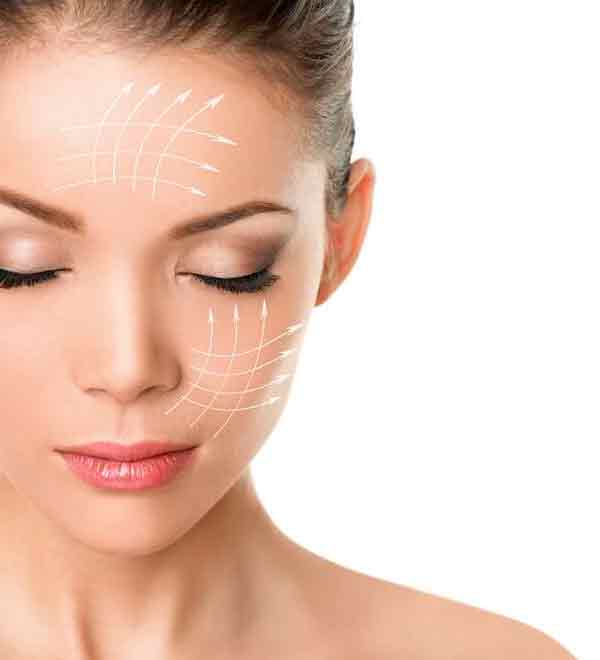
Facial filling with fat (facial fat grafting) is indicated for revitalization and improvement of the contour of the face. Fat is aspirated from certain regions and injected into others. In this technique, the aspirated content is separated, decanted or strained, placed in syringes and injected into the desired regions through thinner needles or cannulas. Since the fat is the patient’s own, allergic reactions or rejections are avoided. However, even with all the care, part of the graft is reabsorbed. To circumvent this problem and ensure a lasting result, it is recommended to fill in more of the indicated places.
On the face, fillers are useful for:
(1) revitalizing the face by smoothing creases and wrinkles,
(2) correcting sunken eyes,
(3) enhancing the lips and cheekbones, and
(4) enhancing the chin.
Fillers can also accompany other procedures, such as liposuction and facelift plastic surgery. Non-surgical fillers with hyaluronic acid can also be used in smaller areas and have immediate results similar to fat fillers, however, they are not long-lasting and need to be repeated after some time.
Surgical technique
- Marking of liposuction areas and fat grafting areas.
- Anesthesia + antisepsis.
- Liposuction and collection of fat in a sterile bottle.
- Separation of fat from the rest of the aspirate and distribution in syringes.
- Fat grafting through existing incisions or new, even smaller incisions.
- Review of bleeding areas.
- Closure of operative wounds + dressing.
Postoperative Guidelines
There will be no need to restrict movement. To minimize the resorption of the injected fat, no pressure should be applied to the grafted area. Sun exposure should be avoided for at least 30 days. Pain and discomfort are temporary and will subside easily with prescribed medication. Purples and bumps are common and will tend to go away.
Facial filler guidelines
- Pain and discomfort are temporary and will subside easily with prescribed medication.
- Avoid driving in the first 3 days after surgery.
- After discharge, it will be important to rest in bed or in a reclining chair. When lying down, keep the headboard elevated 30º for 5 days. Normally, there will be no restrictions on sleeping positioning.
- The day after discharge, you will be able to take a full-body bath, including washing the operated areas. Get in the shower and wash the operated areas with the prescribed soap. Carefully wash operative wounds. Complete the bath with normal soap.
- Always have a separate clean face towel to dry the operated area and a regular towel to dry the rest of the body. In the operated area, press lightly when drying and do not rub.
- From the 1st postoperative day, there will be no need for bed rest. Return to your normal activities, respecting the aforementioned limits.
- To minimize the resorption of the injected fat, no pressure should be applied to the grafted area.
- It is likely that bruises (ecchymosis) and swelling (edema) will appear in the operated areas, which will disappear over time.
- Lymphatic drainage sessions may be recommended.
- Sun exposure should be avoided for the first 30 days after surgery. The use of sunscreen is also advisable.
- More intense physical activities should only be resumed 3 months after surgery (examples: swimming, running, weight training, ball sports).
- You must return to the doctor’s office regularly, as requested, for the removal of the stitches (if any) and evaluation of the evolution of the surgery.
- The outcome of your surgery will depend a lot on following these guidelines correctly. Any questions, contact your doctor.
COMMON QUESTIONS
What is the indication for facial filler?
The facial filling is indicated for women and men who seek to revitalize and improve the contour of the face: attenuate furrows and wrinkles and increase the projection of certain areas.
What is the recommended age?
It is generally a recommended procedure for adult patients.
What type of anesthesia is used in facial filler?
Local anesthesia associated with sedation is the most used, but the surgery can also be performed under general anesthesia. Epidural anesthesia or spinal anesthesia associated with sedation can also be used for areas submitted to liposuction.
How long is the surgery?
Facial filling surgery can last from 1 to 2 hours (depends on the number of areas undergoing liposuction and fat grafting).
What is the length of stay?
The hospital stay is 6 to 12 hours. Usually, the patient is released on the same day.
When will stitches be withdrawn?
When stitches are needed, they will be removed 7 days after surgery.
Does facial filler have risks?
Postoperative complications are rare. These include: fat graft absorption, asymmetry, bleeding, bruising, infection, skin distress, redness, rash, temporary numbness or tenderness, temporary paralysis of facial muscles, and fat embolism.
How long does it take to get the expected result?
A definitive result is achieved after about 6 months. Scars, in addition to being very small, are hidden in natural folds of the skin or can be hidden with underwear or bathing suits. The good result will depend on the technique performed and the lowest possible fat reabsorption.
